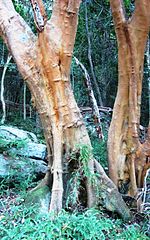| Cape saffron | |
|---|---|

| |
| In flower in a Cape Town garden | |
| Conservation status | |
 Least Concern (IUCN 3.1) | |
| Scientific classification | |
| Kingdom: | Plantae |
| Clade: | Tracheophytes |
| Clade: | Angiosperms |
| Clade: | Eudicots |
| Clade: | Rosids |
| Order: | Celastrales |
| Family: | Celastraceae |
| Genus: | Cassine |
| Species: | C. peragua |
| Binomial name | |
| Cassine peragua L. | |
| Synonyms | |
| |
Cassine peragua, also known as Cape saffron, bastard saffron and forest spoonwood, is a medium-sized tree with fragrant flowers, decorative fruits and a saffron-coloured trunk. It is indigenous to the Afro-montane forests of South Africa.
Appearance
Cape saffron is an evergreen tree which is usually around 2 to 5 meters in height, but can sometimes grow to 15 meters in the right conditions. The tough, round, leathery leaves are usually dark green, but can be copper, orange or scarlet coloured depending on growth.
The bunches of small, bisexual flowers have a strong, but pleasant fragrance, and the fruits are berries that appear as green and then gradually darken to purple and black.
The trunk eventually assumes an orange saffron colour, as the grey bark flakes off exposing the orange under-layer.
Natural distribution
It is naturally distributed throughout the southern and eastern parts of South Africa, including Eswatini. Here it grows in a wide variety of habitats, from deep Afromontane forest to coastal dunes and rocky mountain slopes. In addition to the most common and widespread subspecies, there are two rare dwarfed subspecies (subsp. barbara & affinis) which occur in restricted pockets in the Western Cape.
It is now cultivated as an ornamental garden tree throughout South Africa.
Human usage


Cape saffron has been used locally for centuries for its beautiful, hard wood, which assumes a yellowish-orange colour and was traditionally valued for furniture.
Its more common use now is as an attractive ornamental feature in gardens. It grows slowly, but is very tough and resistant to wind. In exposed positions, in direct sun or wind, it will tend to grow shorter, lower and denser. It forms an attractive, domed shape, with a saffron-coloured trunk and often multi-coloured foliage.
The fruits attract great numbers of birds, and the flowers have a pleasant fragrance.
References
- Botanic Gardens Conservation International (BGCI).; IUCN SSC Global Tree Specialist Group (2019). "Cassine peragua". IUCN Red List of Threatened Species. 2019: e.T147140686A147140688. doi:10.2305/IUCN.UK.2019-2.RLTS.T147140686A147140688.en. Retrieved 11 November 2021.
- ^ "Cassine peragua L." (Online information website). PlantZAfrica.com: The site for information about plants native to southern Africa. Pretoria, South Africa: South African National Biodiversity Institute (SANBI). Retrieved 16 May 2013.
External links
| Taxon identifiers | |
|---|---|
| Cassine peragua | |
This Celastraceae article is a stub. You can help Misplaced Pages by expanding it. |


